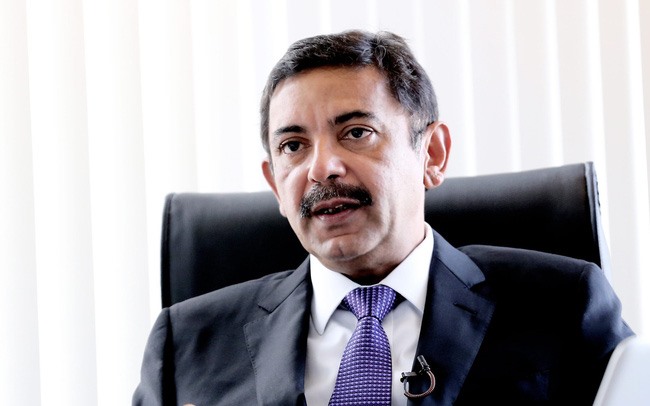 Economy
Economy

 |
| Director of YOLO Shameek Bhargava |
The idea of forming YOLO originated from the desire to create a digital platform capable of reaching and serving millions of new customers quickly – a digital banking platform that has the potential to thrive and break through what we see as the traditional banking model.
With such big ambitions, we have used a completely new, independent technology platform that is different from current banking platforms which use the traditional core banking system. This platform allows us to grow faster than existing technologies of traditional banks. Furthermore, this platform allows us to connect with a diverse ecosystem of services provided by our partners in Việt Nam.
YOLO’s idea is a digital ecosystem with diversified services combined with a bank. Our customers start their day with different needs and rarely with the use of financial and banking services. They repeatedly use taxis, listen to music, watch movies and order food and drinks. YOLO provides customers with daily necessities they need, in addition to the products and services of a true bank. This is a unique combination and the first of its kind in the Asian market.
YOLO is different, a superior form of e-wallet. It acts as a digital bank, which allows us to offer products that most e-wallets do not provide. For example, we offer prepaid virtual cards associated with MasterCard, savings services, interest payments and loans.
YOLO connects to a diverse ecosystem of satellite services. At the moment, we have connected with more than 15 partners in different sectors and services ranging from insurance and healthcare to transport.
We strive to connect to the ecosystem of external services because of one of the biggest challenges faced by digital and traditional banks – the level of interaction between banks and customers is low. Phones today offer hundreds of different types of applications. Banks not only have to compete with each other but also with other apps and services to capture the attention of customers.
If you are not different, not keeping up regular connections with your customers, your app will be forgotten. This is a vital point for digital banks. YOLO wants to overcome the limitations of a digital bank by providing not only banking services but also utilities and services customers use every day.
If you look deeper into today’s digital banking models, some digital banks are not really digital. They digitalise the user interface but still use the core technology systems of traditional banking. YOLO is different; we would like to develop a true digital bank, built on a separate platform, independent from the traditional bank. YOLO is the first digital bank operating on the Amazon Web Service Cloud, allowing us to grow rapidly in both quality and quantity.
I cannot share the exact figure because we are still developing YOLO; however, the model we apply is low cost but highly flexible.
This model allows us to use available technologies to minimise fixed investment costs. The platform we are using is more economical than the core banking system of traditional banks. Technology-based product development is flexible and much quicker. The way we connect with our partners and external services is also very flexible and proactive through APIs and SDKs.
Traditional banks using APIs or connection methods through SDKs are expensive because their old platforms do not allow them to be compatible with new connection methods, driving up investment costs.
This is why we decided not to use the VPBank platform from the beginning. The cost to develop YOLO is about one fifth of the development of a digital bank based on traditional banking technology.
Our ambition when developing YOLO is not to confront or replace specific apps such as food and taxi providers. We want to provide our customers with a platform that offers value beyond bank limits, where customers can use services for their daily lives. YOLO has been in the market for just over one month and customers are very interested in using its many services.
In the near future, we will work with many partners to provide our customers with convenient services. This is a trend that is taking place in the world’s most technologically advanced economies.
YOLO is developed like a Fintech company with speed and flexibility combined with a bank that allows us to offer a wide range of products and services. YOLO operates in a strict manner to comply with regulatory requirements, limit operational risks to its customers, and ensure customer confidence.
These are important parts of YOLO’s superiority in the marketplace.
If you put money into an e-wallet, your money will stay there and be unprofitable. If you put money into YOLO, when you designate an account, you will receive interest each period. Besides, YOLO also has a premium product – YOLO super – to optimize your cash flow and save in the smartest way.
VPBank has partnered with Timo to develop its customer base. YOLO has been developed specifically to access new customers, creating a stand-alone digital bank with independent products in line with the market.
When developing YOLO, we focused on developing new customers and turning them into regular customers by increasing the frequency with which they use the product. In terms of features, we have a long-term product development plan. Our customers now can use the basic services such as payment and savings, and the upcoming update will introduce products such as loans and credit.
Next month, we will launch a QR code payment solution developed by MasterCard called MPQR. We will implement a pilot in Hà Nội and HCM City. With the payment method by QR code, accepting payments will be more convenient and the YOLO mobile payment network will be expanded.
This QR code mobile payment method can be deployed in shops, service points and taxis. We would like to participate in the reform of payment methods, using non-cash payments for large corporations in fast food and retail.
I am in favour of having more products and services related to digital banking and mobile payment. The telecommunications firms’ participation in the financial market is not new in other parts of the world, and I think there will be a similar situation in Việt Nam. On the positive side, having more firms entering the market will help the market be more competitive. This will also help Việt Nam move closer to the non-cash market model.
Having more firms involved in the market will also give us a sense of belonging; we must focus on creating different values for YOLO than our competitors in the market.

.jpg)


